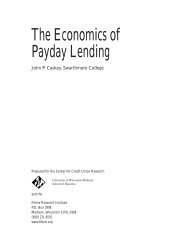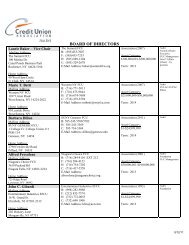CFPB Streamlining Regs Comment Letter - Credit Union Association ...
CFPB Streamlining Regs Comment Letter - Credit Union Association ...
CFPB Streamlining Regs Comment Letter - Credit Union Association ...
Create successful ePaper yourself
Turn your PDF publications into a flip-book with our unique Google optimized e-Paper software.
March 5, 2012<br />
Bureau of Consumer Financial Protection<br />
Docket No. <strong>CFPB</strong>-2011-0039<br />
Research, Markets & Regulations Division, Bureau of Consumer Financial Protection,<br />
1500 Pennsylvania Avenue NW. (Attn: 1801 L Street NW),<br />
Washington, DC 20220<br />
To Whom It May Concern:<br />
On behalf of the <strong>Credit</strong> <strong>Union</strong> <strong>Association</strong> of New York, I would like to take this opportunity to<br />
suggest where regulations can be streamlined and the regulatory process improved to benefit<br />
both consumers and financial institutions. The <strong>Association</strong> believes that this is potentially one of<br />
the most important regulatory notices of the year. In preparing our response, we surveyed our<br />
members, talked to individual credit unions and consulted with our own compliance staff, which<br />
handles more than 5,500 inquiries each year from credit unions across New York State about<br />
how to best comply with the full range of compliance issues. While the following suggestions are<br />
by no means all encompassing, they do highlight the areas where changes would have the most<br />
immediate and beneficial impact without diminishing protections afforded to our members.<br />
When Congress created the Bureau of Consumer Financial Protection it not only gave it the<br />
responsibility for coordinating the implementation and enforcement of consumer protection laws,<br />
but also gave it the responsibility to make the regulatory system more efficient by identifying<br />
redundant and overly burdensome regulations. The importance of this latter responsibility<br />
cannot be underestimated: there are simply too many detailed regulations coming at credit<br />
unions at a fast and furious pace. This is hampering the effectiveness of all credit unions and<br />
posing a threat to the survival of many smaller ones that simply do not have the resources to<br />
dedicate adequate finances to meeting compliance demands and member services<br />
(http://www.cutimes.com/2012/01/16/cus-tally-up-the-rising-cost-of-the-compliance-bur).<br />
A Product By Product Approach Should Be Taken To Regulatory <strong>Streamlining</strong><br />
Regulatory drafting should, whenever possible, start with one simple question: what steps must<br />
the credit union or bank take to legally provide a product or service to its members While this<br />
may seem like a basic point, over the years regulations for many key areas of consumer<br />
protection have become so convoluted that there is no longer a straightforward answer to that<br />
question. One of the most important steps that the <strong>CFPB</strong> could take in reviewing regulations is<br />
to organize the regulations by product. Regulations should serve as a check list for ensuring<br />
compliance.
Reforming Regulation Z<br />
There is no regulation that epitomizes the need for regulatory streamlining more than Regulation<br />
Z, which implements the Truth in Lending Act. The Truth in Lending Act is based on the simple<br />
and laudable proposition that consumers should be able to easily compare the terms of credit.<br />
While its purpose can be reduced to a simple sentence, its application has spawned thousands of<br />
pages of mind-numbing legalese that must be translated into equally confusing consumer<br />
disclosures which, far from helping the consumer compare credit terms, all too often frustrate<br />
and confuse them. These disclosures do, however, provide the basis for lawsuits which also do<br />
little to better inform the consumer about the terms of credit she is receiving. In an ideal world,<br />
Congress and regulators would start from scratch by keeping the statute in place but none of its<br />
regulations. Recognizing that this is not realistic, there are several steps that the <strong>CFPB</strong> could<br />
take to aid financial institutions to more clearly implement these regulations.<br />
Regulation Z should be grouped not by open-end and closed-end credit, but by the most common<br />
products it regulates. The goal would be to make compliance easier by eliminating the need for<br />
cross-referencing regulations and applying terms in different contexts. For example, 12 CFR<br />
1026.5 dealing with form of disclosures provides as follows:<br />
(A) The following disclosures need not be written: Disclosures under §1026.6(b)(3) of charges that are imposed as<br />
part of an open-end (not home-secured) plan that are not required to be disclosed under §1026.6(b)(2) and related<br />
disclosures of charges under §1026.9(c)(2)(iii)(B); disclosures under §1026.9(c)(2)(vi); disclosures under<br />
§1026.9(d) when a finance charge is imposed at the time of the transaction; and disclosures under §1026.56(b)(1)(i).<br />
There are no fewer than seven cross-references, each of which exempts specific products, and<br />
this is the section dealing with general disclosure requirements for open-end-loans. The<br />
problem is that many of the most commonly used financial products today were not in existence<br />
or wide use when these regulations were originally promulgated. As new products came into<br />
existence, they were simply grafted onto the existing regulations. For example, much of the<br />
preceding paragraph could be eliminated if all of the relevant regulations dealing with unsecured<br />
open-end lines of credit were placed in one section and all of the required regulations for<br />
complying with home equity lines of credit were placed in another.<br />
Similarly, as regulators attempt to impose additional notice requirements on subprime loans, the<br />
traditional notion of a closed-end loan does little to aid a practitioner trying to comply with<br />
regulations and provide adequate notices to consumers. For example definitions for a HOEPA<br />
loan (1026.32) provide the following set of definitions:<br />
Definitions. For purposes of this subpart, the following definitions apply:<br />
(1) For purposes of paragraph (a) (1) (ii) of this section, points and fees means:<br />
(i) All items required to be disclosed under §1026.4(a) and 1026.4(b), except interest or<br />
the time-price differential;
(ii) All compensation paid to mortgage brokers;<br />
(iii) All items listed in §1026.4(c)(7) (other than amounts held for future payment of<br />
taxes) unless the charge is reasonable, the creditor receives no direct or indirect<br />
compensation in connection with the charge, and the charge is not paid to an affiliate of<br />
the creditor; and<br />
(iv) Premiums or other charges for credit life, accident, health, or loss-of-income<br />
insurance, or debt-cancellation coverage (whether or not the debt-cancellation coverage<br />
is insurance under applicable law) that provides for cancellation of all or part of the<br />
consumer's liability in the event of the loss of life, health, or income or in the case of<br />
accident, written in connection with the credit transaction.<br />
If the regulations were organized in a more coherent and logical manner, credit unions could<br />
more efficiently provide legally mandated disclosures. In this way, we could move Regulation Z<br />
back towards its original goal as opposed to being little more than a tripwire for compliance<br />
violations.<br />
The <strong>CFPB</strong> has already taken important steps in beginning this process by proposing combined<br />
disclosures for RESPA and Regulation Z. The mortgage process is now so heavily regulated<br />
through virtually every stage of the mortgage process, from the taking of the mortgage<br />
application (Regulation B) to notification that the mortgage has been sold (RESPA), that the<br />
mortgage lending area could easily be grouped as a standalone area of regulation, perhaps even<br />
listed in the order of the process.<br />
Standardized definitions would be another change that would make the regulations easier to use.<br />
While there are narrow circumstances in which a "term of art" needs to be given a definition<br />
unique to a specific section, this should be the exception rather than the rule. How many<br />
definitions of a business day are necessary Once in place a poorly drafted or duplicative<br />
regulation has a multiplier effect, since every financial institution affected by a given regulation<br />
must search out its meaning. A regulation with subtle distinctions also leads to the type of issues<br />
that can only be resolved through litigation.<br />
ATM Fee Disclosures<br />
12 CFR 205.16 currently requires that a member receive both a posted notice that a fee may be<br />
imposed and an electronic notification of the fee being imposed prior to a transaction being<br />
executed. This redundant notice requirement provides little benefit to the consumer and has<br />
actually resulted in credit unions and banks being sued for failing to provide the posted notice.<br />
In creating the statutory framework for regulating electronic fund transfers, Congress provided<br />
that the regulator shall "demonstrate that the consumer protections of the proposed regulations<br />
outweigh the compliance costs imposed upon consumers and financial institutions" (15 USC<br />
1693B (a) (3)). Consequently, while the statute is controlling, the regulator is given the
obligation to ensure that any regulations promulgated pursuant to statutory authority do not<br />
burden financial institutions while providing little benefit the consumers. As applied to ATM<br />
notice requirements, the clear intent of the statute is to ensure that members are put on notice that<br />
a debit transaction is going to cost them money prior to any transaction taking place.<br />
This goal is more than adequately accomplished with the existing electronic disclosures that<br />
inform members precisely how much they are going to be charged.<br />
Improvements to the Regulatory Process<br />
Regulations should detail precisely what changes are being made to existing regulations with a<br />
table that cross-references provisions that will be amended under a given proposal. For example,<br />
the NCUA has proposed changes to the way credit unions account for troubled debt<br />
restructurings. The regulation includes a chart summarizing existing law and the changes that<br />
will be made to the corresponding power under the proposal. Since it is increasingly common<br />
for regulations and their introductory material to include several hundred pages of explanation, a<br />
concise reference point is crucial not only for purposes of researching the regulation, but also to<br />
assess the proposals' overall impact and intent.<br />
Coordination with State Law<br />
Regulations often touch on issues that are already being addressed on the state level. While it<br />
would be impossible for regulatory material to reference all 50 states, there are certain generic<br />
observations which could aid institutions seeking to comply with both sets of mandates. All<br />
regulations should include answer the following questions:<br />
1. Will compliance with this regulation satisfy any legal obligations in this area otherwise<br />
imposed on me by my state (In other words, is it the <strong>CFPB</strong>'s belief that this regulation preempts<br />
state law)<br />
2. Under what circumstances will compliance with a state law or regulation satisfy <strong>CFPB</strong><br />
compliance requirements for a given regulation<br />
3. Why is this issue one that is best dealt with on the federal level<br />
Answering these questions would require the <strong>CFPB</strong> to analyze existing state regulation and<br />
consider the extent to which it is sufficient to address the concern.<br />
The opportunity to examine the regulatory process as well as specific regulations is a unique and<br />
crucial power that has been given to the Bureau. Given the complexity of the regulations and<br />
scope being exercised by the Bureau, it is our hope that this request for information be the<br />
beginning and not the end of an ongoing and systemic look at all of our consumer protection
egulations. I hope these comments are helpful and the <strong>Association</strong> looks forward to participating<br />
in this ongoing dialogue.<br />
Sincerely,<br />
William Mellin<br />
President/CEO<br />
<strong>Credit</strong> <strong>Union</strong> <strong>Association</strong> of New York






